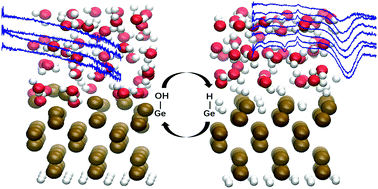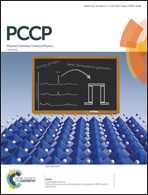Electrode potential dependent desolvation and resolvation of germanium(100) in contact with aqueous perchlorate electrolytes
Abstract
The electrode potential dependence of the hydration layer on an n-Ge(100) surface was studied by a combination of in situ and operando electrochemical attenuated total reflection infrared (ATR-IR) spectroscopy and real space density functional theory (DFT) calculations. Constant-potential DFT calculations were coupled to a modified generalised Poisson–Boltzmann ion distribution model and applied within an ab initio molecular dynamics (AIMD) scheme. As a result, potential-dependent vibrational spectra of surface species and surface water were obtained, both experimentally and by simulations. The experimental spectra show increasing absorbance from the Ge–H stretching modes at negative potentials, which is associated with an increased negative difference absorbance of water-related OH modes. When the termination transition of germanium from OH to H termination occurs, the surface switches from hydrophilic to hydrophobic. This transition is fully reversible. During the switching, the interface water molecules are displaced from the surface forming a “hydrophobic gap”. The gap thickness was experimentally estimated by a continuum electrodynamic model to be ≈2 Å. The calculations showed a shift in the centre of mass of the interface water by ≈0.9 Å due to the surface transformation. The resulting IR spectra of the interfacial water in contact with the hydrophobic Ge–H show an increased absorbance of free OH groups, and a decreased absorbance of strongly hydrogen bound water. Consequently, the surface transformation to a Ge–H terminated surface leads to a surface which is weakening the H-bond network of the interfacial water in contact.

- This article is part of the themed collection: 2017 PCCP HOT Articles


 Please wait while we load your content...
Please wait while we load your content...